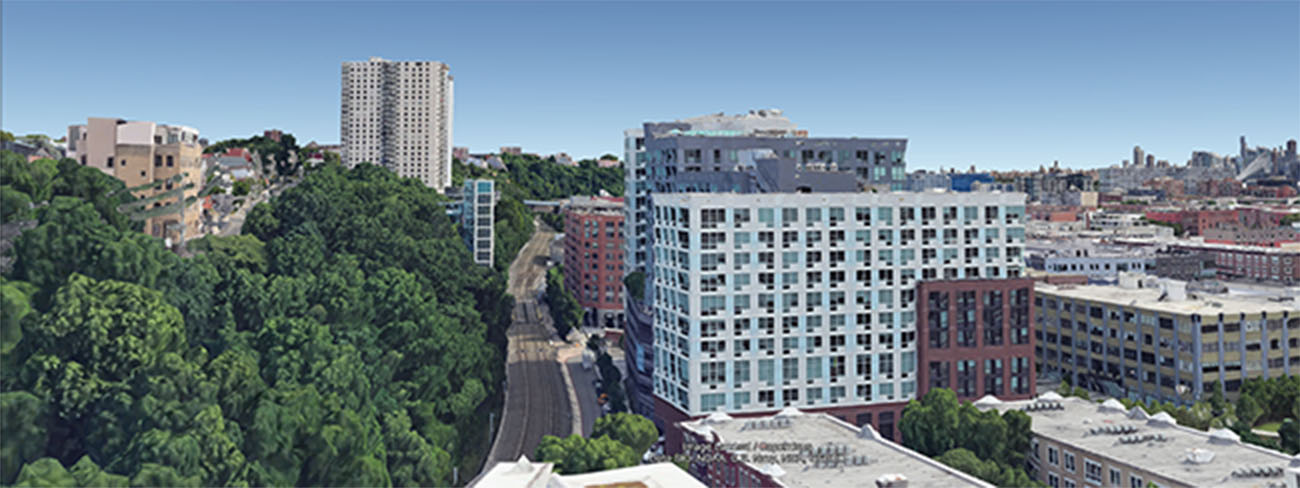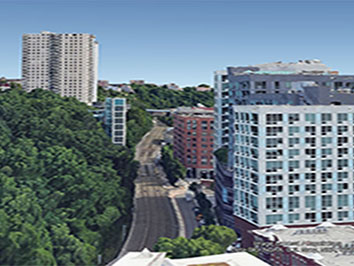
The Palisades Cliffs on the left in Jersey City, the Hudson Bergen Light Rail tracks and new high-rise development at Hoboken’s western border.
FBW | January 24, 2023
On December 21, 2022, the Hoboken City Council approved a redevelopment agreement for 930 Monroe Street, a wall of residential buildings that will stretch from the 900 block of Monroe up to Twelfth Street. A public pathway and bicycle route will run behind the 11-story buildings adjacent to the Hudson-Bergen Light Rail tracks and the Palisades cliffs. This pathway is intended to be part of a “green circuit” circling the perimeter of Hoboken.
Along the waterfront, this green circuit is a clearly defined public space and the rows of shade trees make it exceptionally green. With the completion of a park at Union Dry Dock, the Hudson River Waterfront Walkway will be fully connected in Hoboken from the Hoboken Terminal up to the Weehawken border. This year, the Sinatra Drive Project will complete a two-way, twelve-foot wide protected bicycle pathway for the full mile along the waterfront from Newark Street up to Tenth Street and further extend the rows of shade trees along Sinatra Drive.
In contrast, the green circuit on the west side of town can be difficult to locate and traverse, and does not live up to its “green” moniker, despite the fact that it was conceived as part of the City’s Master Plan some twenty years ago. Major development projects have been completed at 600 Jackson, 700 Monroe and 800 Jackson without a clearly identified pathway for the green circuit. For the six blocks from Ninth Street up to Fourteenth, the green circuit is slated to run behind the new buildings to be built along the light rail tracks.
The Hudson River Waterfront Walkway has faced comparable issues. Since most of New Jersey’s Hudson River municipalities failed to extend the public street grid to the waterfront, the walkway runs behind private developments, abutting backyards. This has created a conflict between the public seeking to use the walkway and property owners whose backyards are typically private. Since the 1980s, New Jersey’s Coastal Zone Management regulations require developers to preserve 30 feet at the water’s edge as a public walk and grant a public easement to the NJDEP.
In the 1990s at Shelter Bay Club in Edgewater, the condo association fenced off the walkway after several units were vandalized. It took years of litigation by the NJDEP to force the owners to remove the fence. The exclusive Bayonne Golf Club has blocked off the walkway at various times sparking strenuous objections by the Hudson River Waterfront Conservancy. Recently, the Conservancy successfully sued the Admiral’s Walk Condo Association in Edgewater for its failure to connect the public walkway at its property. Other similar conflicts have arisen over the years along New Jersey’s privately developed Hudson River waterfront. In addition, the many gated communities in Edgewater with guard houses and gates make the Hudson River Waterfront Walkway more difficult to access.
This experience raises questions concerning Hoboken’s proposed green circuit at 930 Monroe and other sites at Hoboken’s western border. Will a narrow public passageway that runs between the shadow of tall towers to the east and the Palisades Cliffs to the west feel inviting and safe? Will it feel public? Plans for 930 Monroe call for a superblock that will run from Ninth Street up to Twelfth. However, extending Tenth and Eleventh Streets through to the green circuit – something the City failed to do – would have made the greenway more accessible and safe. Extending the east-west streets would also eliminate the long wall of buildings and create clearly delineated development parcels. Finally, if the “green” circuit includes a two-way bike path as well as a pedestrian walk, will there be enough room for shade trees as well?
Related Links
Public vs. Private
Filling the final gaps in the Hudson River Waterfront Walkway
After a contentious, multi-year battle, City will acquire Union Dry Dock
The privatization of part of Pier A Park’s Hudson River Waterfront Walkway
The Public Trust Doctrine
Mapping & Platting
Walking the public walk along the dramatically transformed Bayonne waterfront
A Plan for the Hoboken Waterfront

